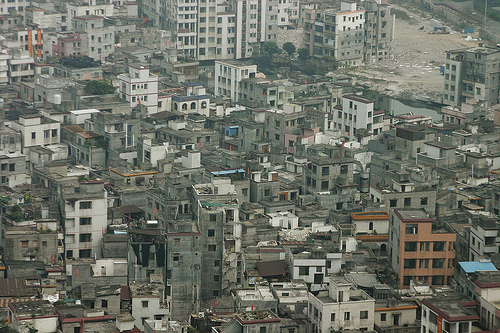Related

Working Paper
/ Feb 12,2015
Making Land Fly
Land Quota Markets in Chinese Urbanization
by
Yuan Xiao

May 01,2013
Grain & Housing Affordability in China
by
Brandon Fuller
At the recent CityLab conference in New York, UP Director Paul Romer suggested that NYC’s land use policies should more effectively leverage the free market. By allowing new development where the demand for housing is highest (often Manhattan), the city could help to keep downward pressure on market-rate rents and prices everywhere. For example, increasing supply in Manhattan would reduce the number of relatively affluent people who leave the island for more affordable neighborhoods in Brooklyn, driving up rents there in the process.
According to Sarah Goodyear, writing for The Atlantic Cities blog, Romer’s comments met with skepticism from Amanda Burden, director of New York City’s Department of City Planning:
“I had believed that if we kept building in that manner and increasing our housing supply … that prices would go down,” Burden said. “We had every year almost 30,000 permits for housing, and we built a tremendous amount of housing, including affordable housing, either through incentives or through government funds. And the price of housing didn’t go down at all. That’s a practitioner’s point of view.”
The Bloomberg administration, Burden included, should be commended for their efforts to increase the supply of housing in New York. That said, a bit of theory can help to explain the price puzzle that Burden describes.
New York’s housing market has a supply side and a demand side. What matters for rents and prices is not simply changes in supply, but changes in supply relative to changes in demand. If city policies do not allow the supply of housing to keep up with increases in the demand for housing, we shouldn’t be surprised when prices continue to rise. By increasing supply, Bloomberg-era housing policies helped to keep prices from rising as much as they would have in the absence of any new construction—but because the policies were too modest to keep up with demand, prices did not fall.
Writing for NextCity.org, Stephen Smith points out that new housing development during the Bloomberg era averaged closer to 20,500 per year than Burden’s figure of 30,000. Smith estimates that, simply to keep pace with national population growth, the city would have had to average more than 30,000 units per year in increased housing. He concludes:
It’s certainly possible that allowing “tremendous” amounts of development, in Burden’s words, would not be enough to stave off price increases and gentrification. But we can’t know that until we actually try. Until now, New York City hasn’t tried.
For the sake of affordability and inclusion, New York City should try. In a recent piece for City Journal, I make the case that there is much that the next administration can do to build on Burden’s efforts to increase the supply of housing:
It should start by scaling-up two Bloomberg-era initiatives. First, it should move ahead with the New York City Housing Authority’s “infill” plan, in which private developers would lease underutilized land in Manhattan public-housing developments. The initiative would provide revenue for much-needed repairs to the city’s public-housing stock and ease demand for units in the city’s more affordable neighborhoods—thus relieving upward pressure on rents and keeping lower-income families from being priced out. Second, New York should relax its restrictions on minimum-unit size, not just in Kips Bay—where developers won a city-sponsored competition to build experimental housing exempt from those requirements—but across the city. Micro-units, already plentiful in Paris and Tokyo, would provide more options for the childless couples and singles that make up roughly half of New York’s households. Smaller units also give the non-rich a chance to live in the city’s most desirable locations. People don’t need to be told how much space to occupy; they can make the size-versus-location calculation for themselves.
Next, the city should legalize basement subdivisions and accessory dwelling units, small residential structures built on the same lot as an existing house. These options would help meet the demand for more affordable housing, particularly among elderly New Yorkers who want to stay put. The units are especially well suited to the outer boroughs, where one- and two-family residences are more common than in Manhattan.
To ease the way for more new housing, New York should also adopt law professors Roderick Hills and David Schleicher’s idea for a zoning budget. Here’s how it works: the mayor proposes a targeted plan for yearly growth in housing supply, and the city council gets an up-or-down vote. This would focus the council on the city’s overall housing needs, not the “not-in-my-backyard” demands that tend to follow specific proposals. Once the plan is approved, the city works with developers to meet housing-growth targets for the year. Until the target is met, down-zonings—reductions in permitted neighborhood densities—are prohibited. Once the city reaches the target, down-zonings can resume, but they must be offset by up-zonings elsewhere, thereby ensuring net increases in the housing supply.
New York can also make use of Schleicher’s idea for “tax increment local transfers,” or TILTs, which use tax revenue generated by new development to compensate neighbors, existing residents, or opponents of a project. If a community board approves a new project in its district, property owners get a tax rebate equal to some percentage of the project’s expected future contribution to the tax base. TILTs weaken community boards’ incentives to derail projects that would otherwise help to make housing more affordable citywide.
I first saw the suggestion to liberalize accessory dwelling units and basement conversions in NYU Wagner Innovation Labs’ Innovation and the City report. For more on the work of Schleicher and Roderick see the papers here and here. We're also excited to be hosting Schleicher for a brown bag discussion here at NYU Stern on November 7th.
Tile image courtesy of Wally Gobetz.
Please fill out the information below to receive our e-newsletter(s).
*Indicates required.